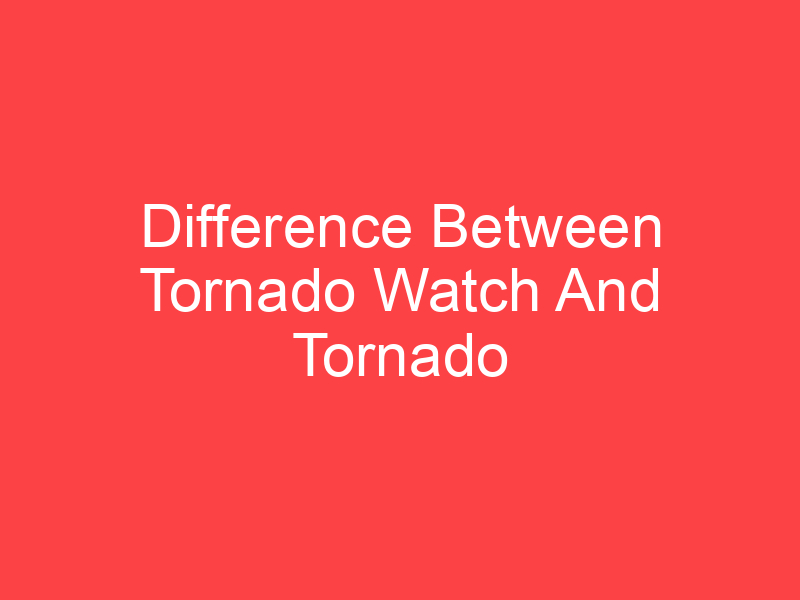Severe weather events such as tornadoes can be unpredictable and dangerous. In the United States, the National Weather Service issues tornado watches and warnings to alert the public of possible tornadoes. However, many people do not know the difference between a tornado watch and warning. In this blog post, we will explore the differences between a tornado watch and warning, and what actions you should take in each scenario.
Comparison Chart
Here is a three-column comparison chart highlighting the differences between a tornado watch and a tornado warning:
| Tornado Watch | Tornado Warning | |
|---|---|---|
| Definition | Conditions are favorable for the development of tornadoes | A tornado has been sighted or indicated by radar |
| Issued by | National Weather Service | National Weather Service |
| Duration | Several hours | Usually less than an hour |
| Preparation | Review safety plan and prepare for severe weather | Take immediate action to seek shelter |
| Actions | Monitor local news and weather reports for updates | Seek shelter in a safe place |
| Safe Places | Stay inside and away from windows and doors | Go to a basement or an interior room on the lowest level |
| All-Clear Signal | Not issued | Issued when the danger has passed |
Note: This chart is not exhaustive and should be used as a reference guide only. Always follow official instructions and guidelines issued by local authorities during severe weather events.
What is a Tornado Watch?
A tornado watch is issued when atmospheric conditions are favorable for the development of tornadoes. During a tornado watch, you should be prepared for severe weather and monitor local news and weather reports for updates. A tornado watch can cover a large geographic area and can last for several hours.
Actions to Take During a Tornado Watch:
During a tornado watch, you should be prepared for severe weather and monitor local news and weather reports for updates. Here are some actions you can take during a tornado watch:
- Stay informed: Keep an eye on local news and weather reports for updates on the tornado watch.
- Prepare your emergency kit: Make sure you have an emergency kit ready that includes a first aid kit, a flashlight, and a battery-powered radio.
- Identify safe shelter: Identify a safe place in your home, such as a basement, storm cellar, or interior room on the lowest level of your home.
- Keep your phone charged: Keep your phone charged and have a backup battery or charger in case of power outages.
What is a Tornado Warning?
A tornado warning is issued when a tornado has been sighted or indicated by radar. During a tornado warning, you should take immediate action to protect yourself and your family. A tornado warning typically covers a smaller geographic area and can last for a shorter duration than a tornado watch.
Actions to Take During a Tornado Warning:
During a tornado warning, you should take immediate action to protect yourself and your family. Here are some actions you can take during a tornado warning:
- Seek shelter immediately: Move to a safe place in your home, such as a basement, storm cellar, or interior room on the lowest level of your home.
- Stay away from windows: Stay away from windows and doors, and cover yourself with a blanket or mattress to protect yourself from flying debris.
- Monitor local news and weather reports: Keep an eye on local news and weather reports for updates on the tornado warning.
- Wait for the all-clear signal: After the tornado has passed, wait for the all-clear signal before leaving your safe place.
Key Differences Between Tornado Watch and Warning:
Now that we have defined tornado watch and warning let us explore the differences between the two alerts.
- Meaning: The main difference between a tornado watch and warning is their meaning. A tornado watch means that conditions are favorable for the development of tornadoes, while a tornado warning means that a tornado has been sighted or indicated by radar.
- Area Covered: A tornado watch typically covers a larger geographic area than a tornado warning. A tornado watch can cover several states, while a tornado warning typically covers a smaller geographic area, such as a county or a portion of a county.
- Duration: A tornado watch can last for several hours, while a tornado warning typically lasts for a shorter duration, usually between 30 minutes to an hour.
- Action Required: During a tornado watch, you should monitor local news and weather reports for updates and be prepared for severe weather. During a tornado warning, you should take immediate action to protect yourself and your family by seeking shelter in a safe place.
- Intensity: A tornado watch indicates that conditions are favorable for the development of tornadoes, but it does not necessarily mean that a tornado will occur. In contrast, a tornado warning indicates that a tornado has been sighted or indicated by radar, and it is important to take immediate action to protect yourself and your family.
Conclusion
In summary, a tornado watch and warning are two different alerts issued by the National Weather Service to warn the public of possible tornadoes. A tornado watch means that conditions are favorable for the development of tornadoes, while a tornado warning means that a tornado has been sighted or indicated by radar. During a tornado watch, you should be prepared for severe weather and monitor local news and weather reports for updates. During a tornado warning, you should take immediate action to protect yourself and your family by seeking shelter in a safe place. Remember to stay informed and prepared, and always prioritize your safety during severe weather events.

